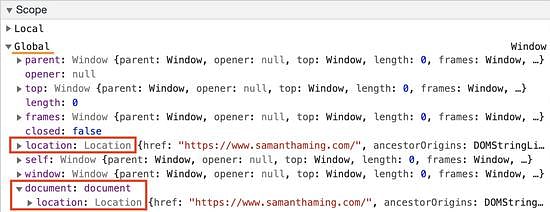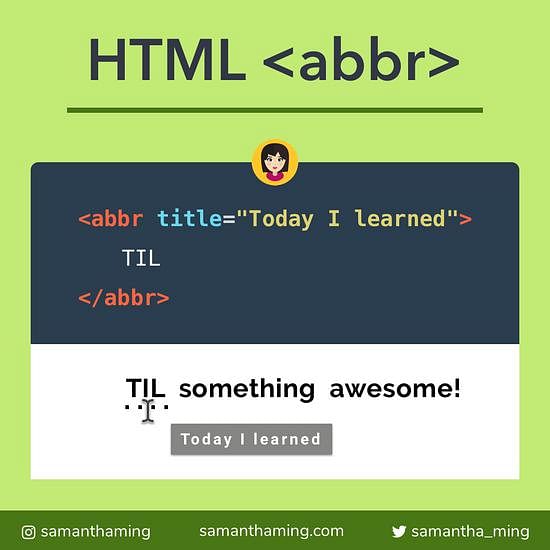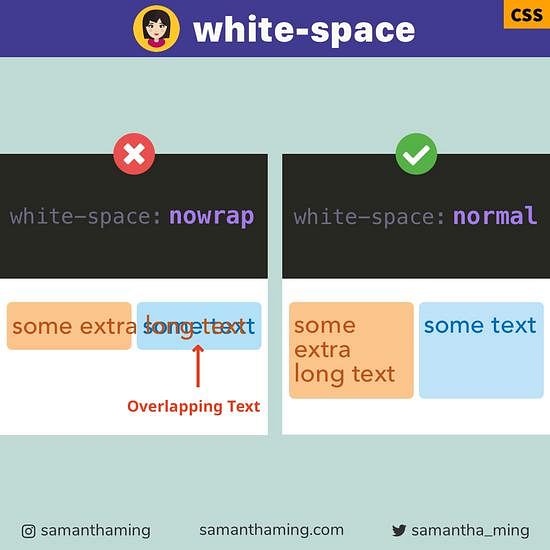# window.location Cheatsheet
Looking for a site's URL information, then the window.location object is for you! Use its properties to get information on the current page address or use its methods to do some page redirect or refresh 💫
https://www.samanthaming.com/tidbits/?filter=JS#2
window.location.origin → 'https://www.samanthaming.com'
.protocol → 'https:'
.host → 'www.samanthaming.com'
.hostname → 'www.samanthaming.com'
.port → ''
.pathname → '/tidbits/'
.search → '?filter=JS'
.hash → '#2'
.href → 'https://www.samanthaming.com/tidbits/?filter=JS#2'
window.location.assign('url')
.replace('url')
.reload()
.toString()
# window.location Properties
window.location | Returns |
|---|---|
.origin | Base URL (Protocol + hostname + port number) |
.protocol | Protocol Schema (http: or https) |
.host | Domain name + port |
.hostname | Domain name |
.port | Port Number |
.pathname | The initial '/' followed by the Path |
.search | ? followed by Query String |
.hash | # followed by the Anchor or Fragment identifier |
.href | Full URL |
# Difference between host vs hostname
In my above example, you will notice that host and hostname returns the value. So why do these properties. Well, it has do with the port number. Let's take a look.
URL without Port
https://www.samanthaming.com
window.location.host; // 'www.samanthaming.com'
window.location.hostname; // 'www.samanthaming.com'
window.location.port; // ''
URL with Port
https://www.samanthaming.com:8080
window.location.host; // 'www.samanthaming.com:8080'
window.location.hostname; // 'www.samanthaming.com'
window.location.port; // '8080'
So host will include the port number, whereas hostname will only return the host name.
# How to change URL properties
Not only can you call these location properties to retrieve the URL information. You can use it to set new properties and change the URL. Let's see what I mean.
// START 'www.samanthaming.com'
window.location.pathname = '/tidbits'; // Set the pathname
// RESULT 'www.samanthaming.com/tidbits'
Here's the complete list of properties that you can change:
// Example
window.location.protocol = 'https'
.host = 'localhost:8080'
.hostname = 'localhost'
.port = '8080'
.pathname = 'path'
.search = 'query string' // (you don't need to pass ?)
.hash = 'hash' // (you don't need to pass #)
.href = 'url'
The only property you can't set is window.location.origin. This property is read-only.
# Location Object
The window.location returns a Location object. Which gives you information about the current location of the page. But you can also access the Location object in several ways.
window.location → Location
window.document.location → Location
document.location → Location
location → Location
The reason we can do this is because these are global variables in our browser.

# window.location vs location
All 4 of these properties point at the same Location object. I personally prefer window.location and would actually avoid using location. Mainly because location reads more like a generic term and someone might accidentally name their variable that, which would override the global variable. Take for example:
// https://www.samanthaming.com
location.protocol; // 'https'
function localFile() {
const location = '/sam';
return location.protocol;
// ❌ undefined
// b/c local "location" has override the global variable
}
I think that most developer is aware that window is a global variable. So you're less likely to cause confusion. To be honest, I had no idea location was a global variable until I wrote this post 😅. So my recommendation is to be more explicit and use window.location instead 👍
Here's my personal order of preference:
// ✅
1. window.location // 🏆
2. document.location
// ❌
3. window.document.location // why not just use #1 or #2 😅
4. location // feels too ambiguous 😵
Of course, this is just my preference. You're the expert of your codebase, there is no best way, the best way is always the one that works best for you and your team 🤓
# window.location Methods
window.location | |
|---|---|
.assign() | Navigates to the given URL |
.replace() | Navigates to given URL & removes current page from the session history |
.reload() | Reload the current page |
.toString() | Returns the URL |
# window.location.toString
Here's the definition from MDN
This method returns the USVString of the URL. It is a read-only version of Location.href
In other words, you can use it to get the href value from the
// https://www.samanthaming.com
window.location.href; // https://www.samanthaming.com
window.location.toString(); // https://www.samanthaming.com
As to which to use, I couldn't find much information as to which is better; but if you do, please submit a PR on this 😊. But I did find a performance test on the difference.
One thing I want to note about these speed tests is that it is browser specific. Different browser and versions will render different outcome. I'm using Chrome, so the href came out faster then the rest. So that's one I'll use. Also I think it reads more explicit then toString(). It is very obvious that href will provide the URL whereas toString seems like something it being converted to a string 😅
# assign vs replace
Both of these methods will help you redirect or navigate to another URL. The difference is assign will save your current page in history, so your user can use the "back" button to navigate to it. Whereas with replace method, it doesn't save it. Confused? No problem, I was too. Let's walk through an example.
Assign
1. Open a new blank page
2. Go to www.samanthaming.com (current page)
3. Load new page 👉 `window.location.assign('https://www.w3schools.com')`
4. Press "Back"
5. Returns to 👉 www.samanthaming.com
Replace
1. Open a new blank place
2. Go to www.samanthaming.com (current Page)
3. Load new page 👉 `window.location.replace('https://www.w3schools.com')`
4. Press "Back"
5. Return to 👉 blank page
Current Page
I just need to emphasize the "current page" in the definition. It is the page right before you call assign or replace.
1. Open a new blank place
2. Go to www.developer.mozilla.org
3. Go to www.samanthaming.com 👈 this is the current Page
4. window.location.assign('https://www.w3schools.com'); // Will go to #3
4. window.location.replace('https://www.w3schools.com'); // Will go to #2
# How to Do a Page Redirect
By now, you know we can change the properties of the window.location by assigning a value using =. Similarly, there are methods we can access to do some actions. So in regards to "how to redirect to another page", well there are 3 ways.
// Setting href properties
window.location.href = 'https://www.samanthaming.com';
// Using Assign
window.location.assign('https://www.samanthaming.com');
// Using Replace
window.location.replace('https://www.samanthaming.com');
# replace vs assign vs href
All three does redirect, the difference has to do with browser history. href and assign are the same here. It will save your current page in history, whereas replace won't. So if you prefer creating an experience where the navigation can't press back to the originating page, then use replace 👍
So the question now is href vs assign. I guess this will come to personal preference. I like the assign better because it's a method so it feels like I'm performing some action. Also there's an added bonus of it being easier to test. I've been writing a lot of Jest tests, so by using a method, it makes it way easier to mock.
window.location.assign = jest.fn();
myUrlUpdateFunction();
expect(window.location.assign).toBeCalledWith('http://my.url');
Credit StackOverflow: @kieranroneill:
But for that that are rooting for href to do a page redirect. I found a performance test and running in my version of Chrome, it was faster. Again performance test ranges with browser and different versions, it may be faster now, but perhaps in future browsers, the places might be swapped.
# Scratch your own itch 👍
Okay, a bit of a tangent and give you a glimpse of how this cheatsheet came to be. I was googling how to redirect to another page and encountered the window.location object. Sometimes I feel a developer is a journalist or detective - there's a lot of digging and combing through multiple sources for you to gather all the information available. Honestly, I was overwhelmed with the materials out there, they all covered different pieces, but I just wanted a single source. I couldn't find much, so I thought, I'll cover this in a tidbit cheatsheet! Scratch your own itch I always say 👍
# Community Input
@jam3sn_codes: This is awesome, I’ve used window.location.href in the past, but didn’t realise how simple it is to access sections of the URL!
If you want to see a live-action of what James is talking about, check out the table of content at the top of this article. Click on it and it will scroll down to the specific section of the page.
// 1. Add the hash identifier as an "id" to any element
<h1 id="top">Top Section</h1>
// 2. Pass that id name as the hash
<a href="https://samanthaming.com/#top">Back to top</a>
# Resources
- MDN Web Docs: Window.location
- MDN Web Docs: Location
- w3schools: window.location
- w3schools: Location
- HTML Spec: Location
- w3docs: How to Redirect a Web Page with JavaScript
- freecodecamp: Window Location
- FrontBackEnd: Difference location.replace, location.assign and location.href
- Medium: How do you redirect to another page in JavaScript?
- Stack Overflow: Difference between window.location.assign() and window.location.replace()
- Stack Overflow: Why does location.toString() report the same as location.href?
- Stack Overflow: Get the current URL with JavaScript
- Stack Overflow: Difference between host and hostname
- Stack Overflow: href property vs. assign() method




